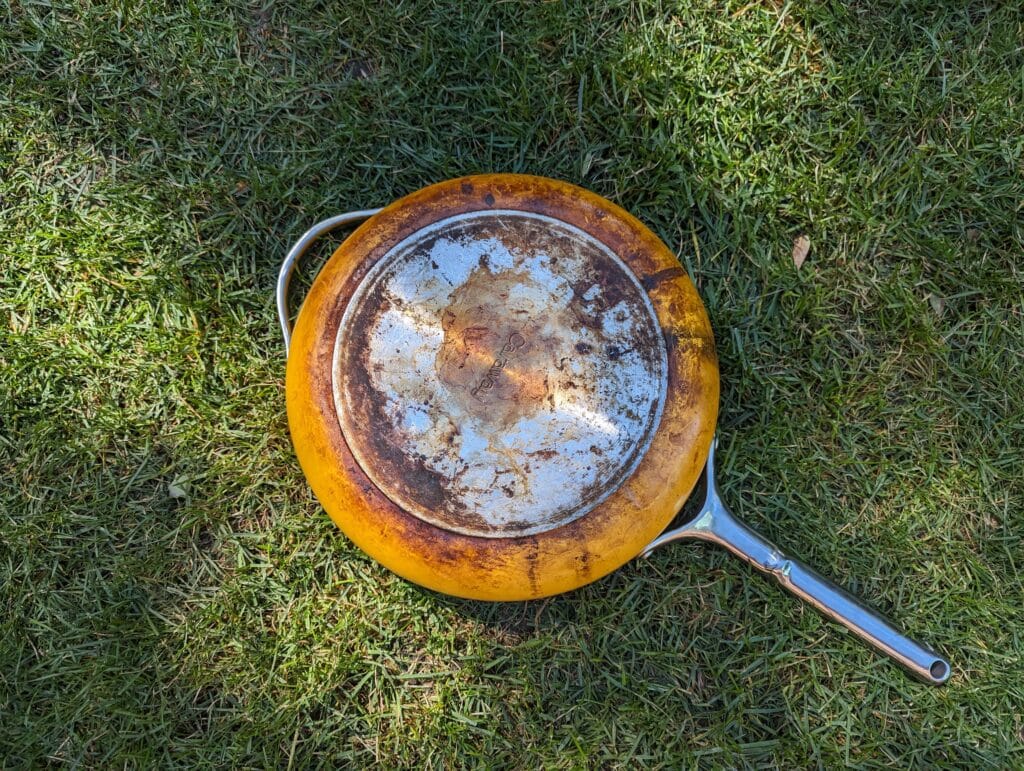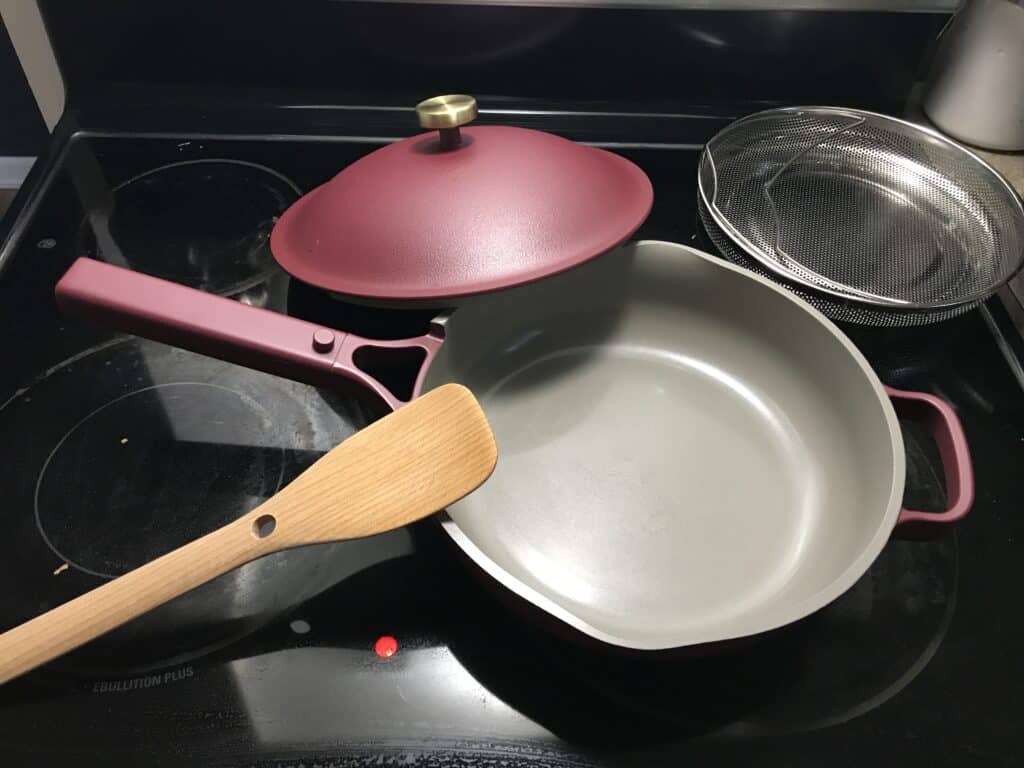Non-stick cookware brands pour hefty ad budgets into beautiful ads on social media, but the sad reality is most non-stick cookware lasts less than two years before it makes its way into a landfill. Here’s what you need to know about the lifespan of your non-stick, as well as how to extend it.

Table of Contents
Non-stick cookware is the kitchen equivalent of fast fashion.
Even the “good guy” brands that last longer (like Alva) tend not to brag about pans lasting just five or so years.
Pans in this genre of cookware typically have a one-year warranty for the coating, even if the pan has a lifetime warranty (Hexclad is a good example). That might mean your pan still functions as a pan, even if the non-stick coating no longer provides a non-stick experience.
What to look for in a long-lasting non-stick pan
- 5-ply construction. There are two outer layers of stainless steel with three layers of aluminum in the middle. The result is better heat conduction and a more warp-resistant base than less robustly built pans.
- Oven-safe. Oven-safe to 600 degrees, which strongly suggests pans are well-made and warp-resistant.
- Reverse rivet design. which helps prevent food getting stuck around exposed rivets. This makes it much easier to keep the pans clean, so they stay non-stick for longer.
- Warranty fine print. One of the best ways to tell the likely lifespan of a non-stick pan is to check the warranty fine print. Make sure to distinguish between the surface warranty and the pan warranty (which are often different).
If it’s been a while since you tried a ceramic coated pan, you might be surprised at how the technology has improved. Most original pans of this genre had just one coating and were easily scratched.
These days, some pans have three or more layers of ceramic, making for a relatively durable, non-stick coating that lasts a lot longer.
How long will Caraway, Ozeri, Scanpan, and other pans last?
While there’s lots to love about Caraway Home cookware, these pots and pans seem to have a short lifespan. Our at-home tests show these pans quickly develop stains and have quite a few scratches after a year of use. The construction also leaves something to be desired, with handles starting to loosen around the one-year mark.
The durability of Ozeri pans, Scanpan, and Cuisinart Green Gourmet pans, as well as GreenLife pans and Ecolution pans is also questionable. We haven’t tried these ourselves as part of our ethos at Leaf Score is to not acquire products we don’t need or think we’ll actually use. As such, we rely on scouring reviews (and running these through fraud detection software) to get a sense of how long these pans tend to last.
Based on our findings, the pans just mentioned seem to lose their non–stickiness within just a few months, even with gentle care, handwashing, and no metal utensil use.
What about Always Pan?
I’m still on the fence about the Always Pan 2.0. The original version suffered from a rapid loss of non-stickiness, but Our Place could have upped its game with its latest coating. Only time will tell.
As things stand, my wife continues to love this pan and her enthusiasm is infectious. After more than four months of near daily use this pan remains impressively non-stick and unscathed.
I’m still expecting the non-stickiness to start failing, though, given the experiences of other reviewers who have had to replace the Always Pan within six months or less.
The Always Pan doesn’t rank very highly on our list of the best non-stick pans either. This is because Our Place won’t reveal toxicity test results or what’s in the coating.

What about GreenPan?
Why GreenPan makes the cut
Although we bumped GreenPan from our recommendations a while ago, due to the company’s poor transparency over toxicity testing and its potential greenwashing, it would arguably earn top spot for the longest lasting non-stick pans.
Why?
Because GreenPan is one of the rare brands that offers ceramic coated 3-ply and 5-ply stainless steel pans that are PTFE-free. The trouble is that we don’t know what’s in the ceramic coating.
This puts us in a funny position where the surface below the ceramic coating (stainless steel) may actually be safer than the ceramic itself.
Either way, the latest generation of GreenPan non-stick pans appears to have a thick, durable coating that lasts for several years. And even when it does develop cracks or chips, the surface below is safe for cooking as it won’t expose you to aluminum.
Because of the durability of GreenPan non-stick pans, we are considering adding GreenPan back to our recommendations, albeit with the same caveats over potential toxicity.
How can I extend the life of my non-stick pan?
The best way to keep your non-stick ceramic pan in good shape is to follow the care instructions that came with your specific pan. These are tailored to the pan’s design, with maximum temperature recommendations and other advice.
In general though, it’s best to:
- Heat ceramic coated pans slowly
- Avoid high heat cooking
- Use wood or silicone cooking utensils (not metal)
- Choose high smoke point cooking oils
- Avoid cooking oil sprays
- Let pans cool before cleaning (to prevent warping and cracking).
As for cleaning and storage, it’s best to:
- Clean ceramic coated pans by hand (avoid the dishwasher)
- Avoid overly abrasive cleaning products and brushes
- Dry pans right away, so they don’t get scratched in the draining rack
- Store pans with trivets or wrapped, to prevent bumps and scratches in the cupboard.
Following these general guidelines can help keep your ceramic non-stick pan in better shape for longer. This means you won’t have to replace your pan too soon, which is more planet-friendly and better for your budget.
Final thoughts on the longest lasting non-stick pans
There’s no getting away from the fact that ceramic coatings don’t last very long. Even the best non-stick pans have a lifespan of just a few years, ten at most, for the ceramic coating itself. In contrast, stainless steel can last for many decades, and carbon steel and cast iron can last almost indefinitely if well cared for.
The good news is that for stainless steel pans with a ceramic coating, you can continue to use the pans even after the coating has a few scratches and chips. It’s not ideal, but the stainless steel surface isn’t toxic and doesn’t leach aluminum into food.